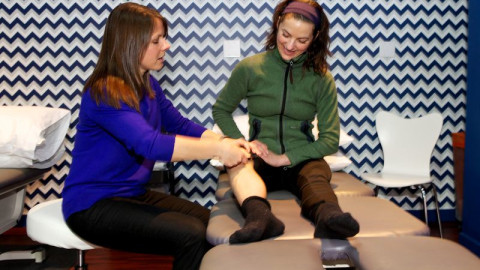Physical therapy first-timer? What exactly are you in for on your first physical therapy visit? First off, dress comfortably because you will be moving. By the end of your evaluation, you should have a clear idea of your assessment and physical therapy treatment goals. You and your PT will create an individualized treatment plan to help you with your recovery.
What Is Physical Therapy?
You probably have a general idea about what a physical therapy is and what a physical therapist does. But why exactly are you going to a physical therapist? What sets them apart from other healthcare providers? Physical therapists are experts on the dysfunction of the body’s musculoskeletal and nervous system. Currently, to become a licensed physical therapist, you must earn a doctorate degree in physical therapy, complete intensive clinical internships, and practice extensively in the clinic. PTs are trained to both diagnose and treat movement dysfunctions. Like most medical professionals, physical therapists can treat a wide-variety of acute injuries and long-term chronic conditions and also rehabilitate patients pre- and post-surgery. Besides injury treatment, physical therapists also provide injury prevention conditioning and wellness services.
Think of physical therapists as biomechanists for your body. By treating the mechanics of your body’s movement, they aim to get you back in optimal shape.
Let’s Evaluate
Your first PT visit is the evaluation. During the 45 to 60 minute session, you and your PT will review your medical history as it relates to your musculoskeletal problem(s) and perform objective testing to help diagnose your injury and determine the future course of treatment. Prepare yourself for the standard questions. Where does it hurt? What makes it better? What makes it worse? Your PT also wants to get a good idea about your general health. They’ll perform a screening of your main body systems (i.e. musculoskeletal, neuromuscular, cardiovascular, pulmonary, and integumentary) to gauge how interrelated your symptoms may be. This often includes taking your blood pressure, your weight, and your height.
Any treatment stemming from your physical therapy evaluation needs to be scientifically crafted and implemented. They’ll consider your range of motion, strength, joint mobility, flexibility, posture, and movement patterns. By assessing your gait, a PT may be able to diagnose movement compensation patterns and find further clues as to what is driving your problem. From there, they can piece together how this may or may not impact your specific injury. With baseline measurements of your current status, your PT will be able to specifically compare improvements made in future sessions.
Start Treatment On Day One
Prepare to start on your treatment plan with your PT that very day. Physical therapy isn’t supposed to be painful. You’ll be moving, stretching, and having your joints and muscles mobilized using hands-on manual therapy techniques depending on your injury. Day one is the beginning of your rehabilitation progress. Some injuries are more complex than others and remember that healing does take time.
At some point you may be thinking “why were they checking my neck if the problem is in my shoulder?”. Sometimes, your physical therapy evaluation will include parts of your body that don’t seem related to your injury. Your evaluation will be comprehensive to include all factors that may be contributing to your problem as well as a concentrated analysis of your particular injury.
Can You Recover Without Going To Physical Therapy?
While some injuries do heal on their own, physical therapy can help improve the healing time and quality of your recovery. Googling can only take you so far in the case of self-treating your injury, as is the case with most medical conditions. Remember, PTs are experts on your body’s musculoskeletal system. Their therapy program will be tailored to make you feel better and function at a higher level. By the end of your session, your PT will have mapped out a treatment plan specific to you and your body.
Feel free to ask questions. Your involvement on your treatment plan is crucial to your healing. Your PT wants to be able to guide you as effectively and positively as possible. At Therapydia, you will have access to our online patient portal, PT Anywhere, to communicate with your PT in between visits. We encourage questions, comments, and concerns at your first visit and for the duration of your physical therapy treatment.











